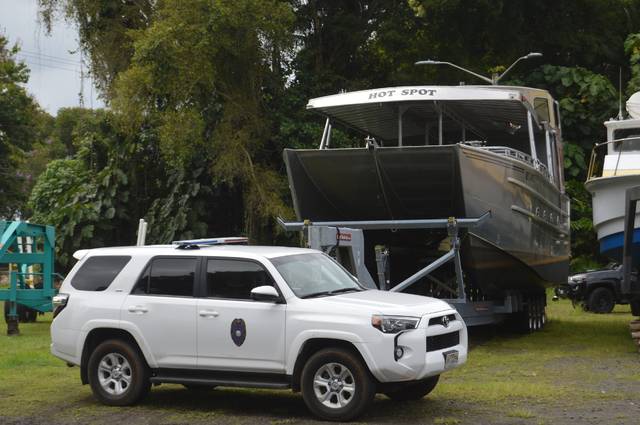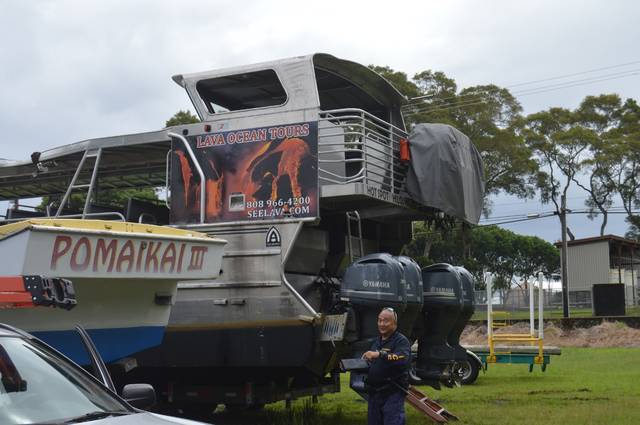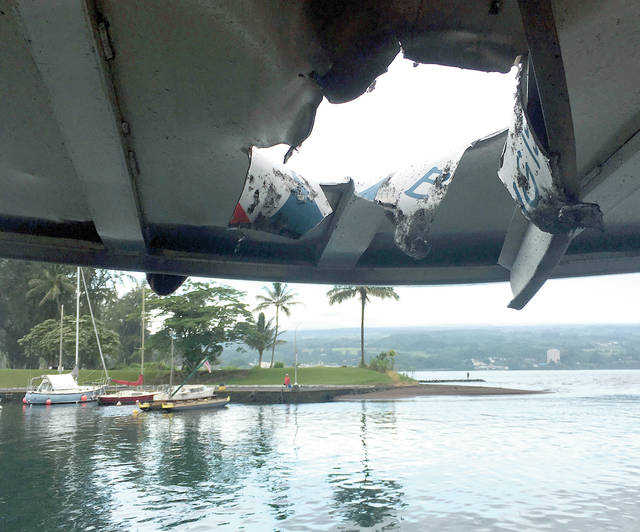23 people injured after tour boat hit by ‘lava bomb’

SHANE TURPIN

JOHN BURNETT/Tribune-Herald A front view of the Lava Ocean Tours boat “Hot Spot” Monday morning at Wailoa Small Boat Harbor in Hilo.

JOHN BURNETT/Tribune-Herald
A police officer secures the Lava Ocean Tours boat “Hot Spot” Monday morning at Wailoa Small Boat Harbor in Hilo.

This photo provided by the Hawaii Department of Land and Natural Resources shows damage to the roof of a tour boat after an explosion sent lava flying through the roof off the Big Island of Hawaii Monday, July 16, 2018, injuring at least 23 people. The lava came from the Kilauea volcano, which has been erupting from a rural residential area since early May. (Hawaii Department of Land and Natural Resources via AP)
HILO — The captain of a lava tour boat hit by what authorities called a “lava bomb” Monday morning near the Kapoho lava ocean entry said he never saw the explosion that rained molten rocks down on top of his boat.
HILO — The captain of a lava tour boat hit by what authorities called a “lava bomb” Monday morning near the Kapoho lava ocean entry said he never saw the explosion that rained molten rocks down on top of his boat.
Shane Turpin, owner of Lava Ocean Tours and captain of the boat “Hot Spot,” said he and his tour group were in the area for about 20 minutes before he piloted the boat closer to shore to get a better view. He said the explosion occurred as they were leaving.
“As we were exiting the zone, all of a sudden everything around us exploded,” he said. “It was everywhere.”
Turpin said he and his tour group had made numerous passes by the ocean entry from about 500 yards offshore.
He didn’t observe “any major explosions,” so he navigated his vessel closer, to about 250 yards from the lava.
As they were leaving the area, the explosion came and engulfed the boat from behind, he noted.
Turpin said he had no idea just how big the blast was until he saw video of the event later on shore.
“It was immense,” he said. “I had no idea. We didn’t see it.”
The blast burned through the roof of the boat, leaving a gaping hole and injuring 23 people, one seriously.
Hilo Medical Center spokeswoman Elena Cabatu said a 20-year-old woman who was admitted in serious condition with a broken femur was later medevaced to Oahu for further treatment. She was brought to HMC shortly after 7 a.m. by ambulance. Three others brought by ambulance and nine who drove themselves to the hospital were all treated at the emergency room and released.
Cabatu said the others sustained “burns and abrasions.” She said emergency room staffers were “inundated” with the sudden influx of patients, but said the night shift remained to help the day shift deal with the injured.
Janet Babb, Hawaiian Volcano Observatory geologist and spokeswoman, said explosions that happen when lava hits water can hurl rocks “the size of a breadbox.”
“I’ve seen large blocks of rock blasted hundreds of feet inland,” Babb said, adding rocks of similar size can presumably be launched seaward just as frequently.
Babb said the volume of lava entering the ocean — fissure 8 was previously estimated to emit between 50 and 100 cubic meters of material per second — is significantly higher than other lava entries in recent memory, which might account for more frequent explosions.
Turpin, who has captained lava tour boats for many years and has lived on the Big Island since 1983, said there were no warning signs prior to the blast.
“There’s something new. There’s something really new,” he said. “And I’ve been documenting them a bit.”
Turpin said he visited the woman who was seriously injured in the hospital and described her and her family as “just really good people.”
He added that after the boat was hit, those in the tour group quickly pulled together to help one another.
“What I saw in humanity this morning was amazing. I mean, this was a group of people that never met before, and they were brought together,” he said. “In all honesty, we definitely evaded a catastrophic event today.”
The lava at the ocean entry is coming from the Kilauea volcano, which has been erupting continuously for the past 35 years.
On May 3, its eruption entered a new phase when it began spurting lava through newly formed fissures in the Leilani Estates subdivision in the volcano’s lower East Rift Zone. It has destroyed more than 700 homes in lower Puna since then. But the only serious injury during the past two months was to a man who was hit by flying lava rock that broke his leg.
The U.S. Coast Guard in May instituted a safety zone where lava flows into the ocean off the Big Island. It prohibits vessels from getting closer than 984 feet (300 meters) from ocean-entry points. The Coast Guard said tour vessels have operated in lower Puna going back at least 20 years.
Jason Redulla, chief of the state Department of Land and Natural Resources Division of Conservation and Resources Enforcement, said four companies have permits to operate in the area, including Lava Ocean Tours. He added that Monday’s incident is a reminder of how dangerous the eruption is and why officials have tried to keep the public at a safe distance.
“At this point, the department encourages the public to follow all of the emergency rules that are in effect and all of the directions from the Civil Defense Agency, which basically means view lava at a very safe distance (and) do not go into the restricted areas unless you have the proper authorization to do so,” Redulla said. “So really it’s a very individual compliance thing where everybody needs to be responsible for their own safety and follow all the laws, regulations and get the necessary approvals.”
The Coast Guard, DLNR and Hawaii Police Department are investigating the tour boat incident.
The Associated Press contributed to this story.



More like 20-50 yards offshore , no?
Videos can be deceiving, but that looked at least 100 yds to me. Only the GPS that was confiscated by the Coast Guard will tell the exact location. BUT……. Did the Coast Guard measure the coordinates where the end of the Lava flow was at the time of the accident?
The flow is adding more land as we speak. Can’t use the GPS info if it wasn’t measured. Both sides of any litigation would have a hard time using the GPS info.
250 yards … a lot less than 300 meters! About 60 yards less?
And “250 yards” was the *captain’s* own estimate, so it’d be reasonable to wonder whether they may have been even closer than that.
This article has some inaccuracies. It doesn’t mention that the USCG allowed a few permitted lava tour boats to approach up to 50 meters of the lava, not 300 meters. This distance was actually changed just a few days ago. It used to be 100 meters but USCG bowed to pressure from at least one of the tour boat companies and changed it, although a different company opposed it saying that was too dangerous. I believe that USCG bears a lot of responsibility for this ill-informed decision and placed the public’s safety at risk. There should be a full investigation into why they made this change and who made it.
If they (USCG) was permitting tours to get that close — they should be criminally liable.
The captain gambled… and lost. Unfortunately, the risk was not his alone to bear, and the consequences will now be felt by the victims, the lava tour boat industry, and the Big Island’s tourist economy (to some unknown extent). About the only “positive” appears to be that no one lost their life.
Best wishes go out to the most seriously injured woman especially, as well as the other injured victims, for a full, speedy recovery.
When you try to see lava on land they keep you back like 1/2 mile or so … why should ocean approach being any different? Bowing to pressure from tour boat operators, are you kidding me? Sounds like USCG and this tour boar operator could be in for a heck of an ugly civil suit…
Just to put this is perspective 3 people died yesterday in car accidents. If the issue is really public safety and we are genuinely concerned we are looking at the wrong culprit.
What? What culprit? Judge and jury in one? Investigation just started.
The U.S. Coast Guard rule to keep a distance of 300 m = 328 yards from the lava ocean entry was clearly violated:
The boat got as close as „about 250 yards“ and the accident occurred while leaving from this prohibited zone. The boat was within a remaining 78 yard wide zone of potential danger according to the just issued USCG rule !
A speedy recovery to all injured persons.
This accident did not need to happen.
This boat doesn’t look even seaworthy to me! Is that a joke?